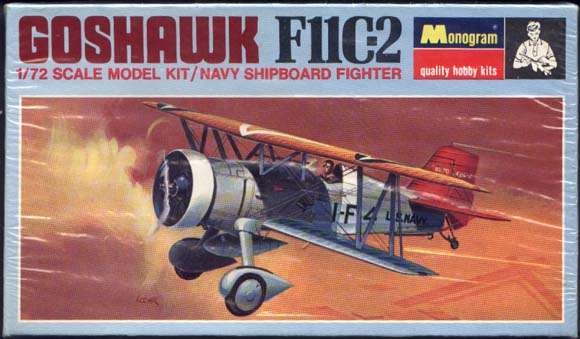
Monogram 1/72 F11C-2 Goshawk
|
KIT # |
PA-210 |
|
PRICE: |
$.70 in 1968 |
|
DECALS: |
One aircraft |
|
REVIEWER: |
|
|
NOTES: |
Classic kit from the '60s |

|
HISTORY |
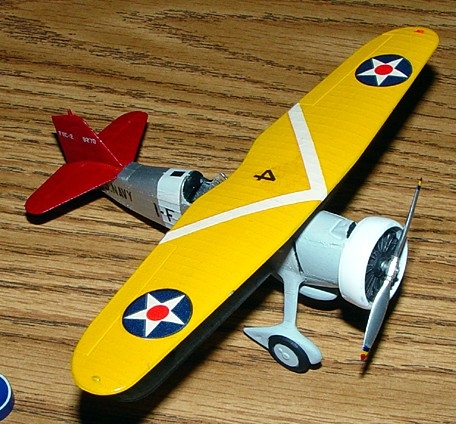
The Curtiss Goshawk was a U.S. Navy fighter and dive-bomber in service from 1933 to 1938 with VF-1B “High Hat”. This was a record for peacetime deployment of the same aircraft in the same squadron. Goshawks later received the designation BFC-2 to indicate their dual role as bomber-fighters. They were also given raised turtlebacks and partial canopies. The Goshawk was heavily exported, and saw combat in China, Thailand and South America. Ernst Udet purchased two examples for the fledgling Luftwaffe after Udet saw a dive-bombing demonstration in America. The F11C is thus the progenitor of the WWII Stuka.
|
THE KIT |
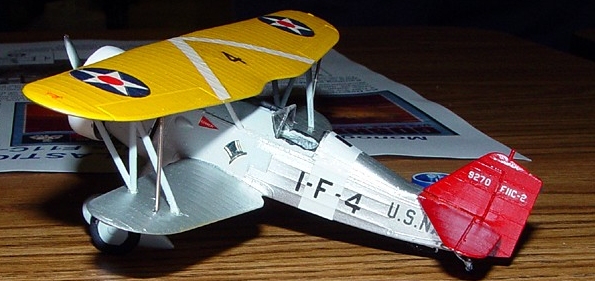 One of three biplane fighters
of the 1930s put out by Monogram in the 1960s. Like the others, the F11C-2 had
the cabane struts molded as part of the fuselage halves making alignment of the
top wing a snap. The gear legs were also integral with the fuselage. Nice fabric
effect, crisp detail, and a well-molded radial engine made this kit one of the
better ones of the period. Its only drawback is a lack of cockpit detail. This
model has not been reissued for some time and should be snapped up on sight. No
known aftermarket accessories or decals are available. This is an excellent kit
for beginners.
One of three biplane fighters
of the 1930s put out by Monogram in the 1960s. Like the others, the F11C-2 had
the cabane struts molded as part of the fuselage halves making alignment of the
top wing a snap. The gear legs were also integral with the fuselage. Nice fabric
effect, crisp detail, and a well-molded radial engine made this kit one of the
better ones of the period. Its only drawback is a lack of cockpit detail. This
model has not been reissued for some time and should be snapped up on sight. No
known aftermarket accessories or decals are available. This is an excellent kit
for beginners.
|
CONSTRUCTION |
Kit construction was basically out of the box. Parts fit is excellent and presents no difficulties to the beginning modeler. The exploded view makes the directions easy to follow. Step 2 calls for flaring the end of the propeller shaft with “the heated blade of an old knife” after slipping the shaft through the motor – ah, the good old days! I chose not to do this so that the propeller can be removed for shipping.
|
PAINT & MARKINGS |
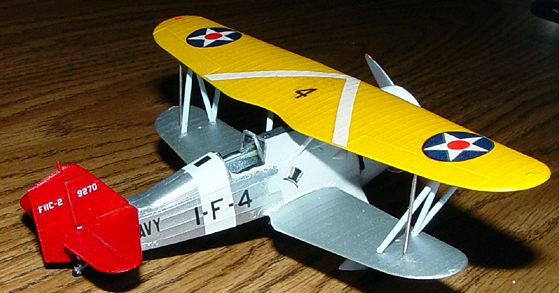 USN aircraft of the 1930’s had some of the most colorful
schemes of the period. Standard colors were Chrome Yellow for the wings,
Aluminum Dope fabric elsewhere, with metal parts such as cowlings being Light
Grey. To that were added Cowling and Fuselage bands, as well as wing chevrons,
to indicate the Section color. These bright markings were enhanced by the tail
codes, each carrier having a distinct color for their aircraft. At the time of
the Goshawk’s introduction in February 1933,VF-1B on Saratoga was recognized by
the Red tails of their planes. The kit markings give the White cowling, fuselage
stripe, and wing chevron of the leader of the second section, aircraft # 4 flown
by Lt. Thomas S. Combs. This plane had BuAer serial number 9270, making it the
sixth production F11C-2.
USN aircraft of the 1930’s had some of the most colorful
schemes of the period. Standard colors were Chrome Yellow for the wings,
Aluminum Dope fabric elsewhere, with metal parts such as cowlings being Light
Grey. To that were added Cowling and Fuselage bands, as well as wing chevrons,
to indicate the Section color. These bright markings were enhanced by the tail
codes, each carrier having a distinct color for their aircraft. At the time of
the Goshawk’s introduction in February 1933,VF-1B on Saratoga was recognized by
the Red tails of their planes. The kit markings give the White cowling, fuselage
stripe, and wing chevron of the leader of the second section, aircraft # 4 flown
by Lt. Thomas S. Combs. This plane had BuAer serial number 9270, making it the
sixth production F11C-2.
|
CONCLUSIONS |
This is an excellent kit, not merely for its nostalgic value. The F11C-2 represents one of the most colorful periods in aviation history and is an essential addition to any collection of Golden Era aircraft. It goes together well and is an easy build for the less experienced modeler. Highly recommended.
|
REFERENCES |
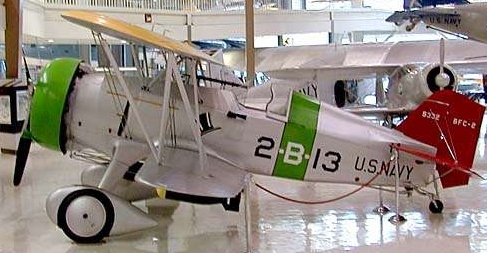 Curtiss Navy Hawks in Action (#156), 1995 Squadron/Signal
Publications
Curtiss Navy Hawks in Action (#156), 1995 Squadron/Signal
Publications
Navy Air Colors (Vol. 1 1911-1945), 1983 Squadron/Signal Publications
American Combat Planes, Ray Wagner, 1968 Doubleday & Company
Museum of Naval Aviation Web Page: www.naval-air.org
If you would like your product reviewed fairly and fairly quickly, please contact the editor or see other details in the Note to Contributors.
Back to the Reviews Index Page